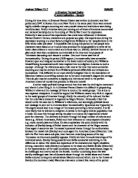It is once the initial entrances are over when their appearances are developed. Specifically the use of colour and light in the play reflects the women’s natures. The fact that Blanche is never seen in direct light enhances her unreality. Continuing with the moth simile, it is as if she is scared of the light and may be damaged by it. There is no doubt that Blanche looks beautiful in the soft, pastel shades. But it is not a natural beauty: it is not like Stella’s. At the beginning of Scene Four, Williams writes “her face is serene in the early morning sunlight”. She needs no false light; her face can withstand it. This could also be applied to the personalities of the two sisters: whereas Blanche’s mind is always thinking of what could be, Stella always sees it as it is – her mind, like her beauty, is firmly within the limits of (the sometimes harsh) reality. Even their clothes reflect this. Blanche only ever wears floral print dresses and jewellery, even at home, whereas Stella is more practical, and wears more comfortable clothes.
This brings us on to the second category: personality. Stella’s entire personality is realistic and down-to-earth. She is always practical, such as when asking, “Did it stain?” when whisky is spilled on Blanche’s dress. Blanche, on the other hand, is quite romantic, and reality is unimportant to her. An effective example is the different approaches of the two women to the loss of their childhood home. Blanche is extremely reluctant to admit the truth, and even when she does so, she is very vague; “…it slipped through my fingers”. Stella is the complete opposite. When she tells Stanley the same news, she simply comes right out with it: “Stan – we’ve lost Belle Rêve!”
As the play develops, one begins to think that Blanche is not a particularly kind person. She appears to be deceitful: she hides things from her sister, such as her drinking problem. She lies about her age. All of this seems to be for her own sake – to make her image seem better to other people. Her vanity governs her. She says to her sister, “You haven’t said a word about my appearance”. She is constantly bathing and changing clothes. She dislikes harsh light.
Stella also keeps things from her sister. She hides the fact that she is pregnant; but whereas Blanche lies at the expense of her sister (for example, her age), Stella is deceitful for Blanche’s sake. She says, “Don’t mention the baby” because she wants to wait “until [Blanche] gets in a quieter condition”. She even tells Stanley to be deceitful to Blanche (“Be sure to say something nice about her appearance”), because she knows what Blanche wants to hear.
Obviously Stella cares for her sister immensely. She complies with her wishes by turning off the lights; she fetches lemon cokes for Blanche whenever she is asked; and when Stanley is talking rather loudly about just how he feels about Blanche, Stella says, frightened: “Hush! She’ll hear you!”
At the end of the day, Blanche is not like this at all. Ostensibly she appears to be a very refined, very polite Southern Belle. Yet there are moments when her true personality is uncovered, with just one line. This does not happen often, and so it seems that Blanche tries very hard to put on an act. But when it does happen, her words are biting, and she reveals herself to be inconsiderate, selfish and tactless. Powerful examples are “I meant to be nice about it” (referring to Stella’s apartment) and “In bed with your – Polack!” (a dig at Stella for leaving Blanche to sort Belle Rêve out on her own).
Both women in the play have slightly more superior speech than standard American English, to indicate their backgrounds. But even through their language, their personalities shine. Nearly everything Blanche says is either romantic or old-fashioned. That is not to say that she is old; rather, it suggests that she is well educated and sophisticated. Phrases such as “I hereby endow” are good examples (this is also sarcastic and condescending, which shows up her personality). As for her romantic language, it is extreme and sometimes almost poetic in nature: “I … bled for it!” And her use of pet names, such as “Stella for star” and “precious lamb”, highlights her falsely innocent nature.
Stella is not so elaborate with words, and is more simple and direct with language. Like Blanche, she expresses her feelings, but she manages to do it in a much easier way: “I don’t care about papers!” and “Don’t be such an idiot!” This language can actually be seen as condescending, but it is not – at least, it is not as much as Blanche’s is. Blanche’s language seems sweet and light, but it has darker undertones – she is acting superior to others.
So far, it can be concluded that appearances in A Streetcar Named Desire are extremely deceptive. As the play progresses, one finds out that the two sisters are not like one’s first impressions of them. Blanche, at first sight, is delicate, dainty, innocent and refined. Yet her personality is at times revealed to be fiery, selfish, tactless and vain. Stella, also beautiful, still seems to be plainer in comparison to Blanche. But as one learns more about her, one discovers she is receptive to other peoples’ feelings, thoughtful, sincere and kind, and is always submissive to those who need something.
Throughout the play, there is really only one person who sees the two women for what they are from the very beginning: Stanley Kowalski. Consequently, he treats them as such. When all is said and done, Stanley is a man’s man. To him, women are somewhat inferior and are there to please the men. There is evidence for his belief that women are toys, such as him slapping Stella on the backside at the poker game. The line, “Why don’t you women go up and sit with Eunice?” shows that he feels women should stick together and not get in the men’s way. This also indicates that he has a lack of respect for women – again, throwing Blanche’s clothes and belongings from the trunk around the room is evidence of this.
Stanley does not like Blanche at all. At the start, he is wary and only nice out of politeness, and as the play progresses he treats her less and less nicely. But it is unlikely that he treats her this way solely because she is a woman: otherwise one would see similar treatment of Stella and Eunice. It is likely that he resents her because she is of a higher class, and that she acts like it. She always pretends to be superior, and this angers Stanley because he knows the truth about her, or at least suspects something. When put this way, one can almost understand what Stanley feels. He hates to see someone in his apartment, deceiving his wife, and arguing with him. There is a constant struggle between Stanley and Blanche, and it is almost like a tournament with several rounds or stages. The “object” that is being fought over is Stella. During these fights, Stanley treats Blanche like a man with the things he says, but both his and her actions are very provocative. Stanley exerts his superiority by shouting loudly and moving close to Blanche, whereas Blanche flirts, doing such things as giggling, calling him names and spraying at him with perfume. This is a good tactic for Blanche, because it angers him more, but he is unsure of how to react. Nevertheless, Stanley always “wins” Stella, and he knows it: his evil grins at Blanche over Stella’s shoulder just scream “I’ve won”.
But Stanley loves Stella fiercely. Theirs is a love that is passionate and very sexual. The many animal references in the play highlight the nature of the relationship between them. It is very stormy, but both Stanley and Stella like it this way. Although Stanley will always put his foot down with Stella and get mad with her (such as being rough with her or throwing his plate on the floor), he has a certain amount of respect for her and will let her argue or give him orders sometimes (“Don’t be such an idiot!”). The fight during the poker night is perhaps the best example of a conflict between Stella and Stanley. They do not stay away from each other for long. Stanley screams up to Stella from below, crying. This is excellent evidence to indicate how fiercely he loves her, since his manly image here is shattered.
Mitch is very different. He is a woman’s man. He treats both women like ladies, and acts as a gentleman in their presence, saying things such as “Be glad to” and “I believe you are right about that”. He is receptive to the women’s feelings, and this is shown when he says regretfully, “Poker should not be played in a houseful of women”. He is the only man in the play, apart from the young man who calls round for donations, to treat Blanche how she wants to be treated (but not at the end, of course). He is considerate to her because they have things in common: their language and attitudes are similar and, most importantly, they are lonely. They have both lost someone they loved, and they can find comfort in each other.
Finally, there is the way that the two women treat others of the same sex. Stella never treats Blanche with anything less than total devotion and love, right up until her sad departure. Outwardly, Blanche seems to treat Stella lovingly, but there is always something there that suggests Blanche feels she is superior to Stella, such as the pet name “precious lamb”, and commenting on how fat she is getting. But there is no doubt that Blanche does love Stella – indicated by her constant pleading with Stella to move away from Stanley and go with her. And, both Stella and Blanche are capable of being quite malicious when they speak of Eunice upstairs and the effect on the ceiling when she engages in night time activities with Steve. Here Williams is just showing that there is a certain evil joy and maliciousness in everyone, regardless of gender.
All in all, at the risk of sounding sexist, I believe that Williams is commenting on two things: the complexity of women, and the treatment of women. The first is obvious: as Blanche indicates, some women are capable of simultaneous emotions and even multiple personalities. And secondly, that women in the play and perhaps in Williams’ society were still regarded as unequal and in some cases inferior by the men (with exceptions such as Mitch, of course), and that some women can earn more respect than others, depending on their own attitudes and actions (such as the differences between Blanche, who was dishonest, and Stella, who was totally honest). I might just point out that this could be said of most men as well, and that this conclusion works equally well if the genders are reversed.







